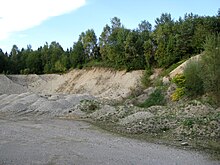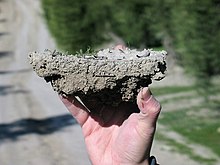In the Earth sciences, aggregate has three possible meanings.



In mineralogy and petrology, an aggregate is a mass of mineral crystals, mineraloid particles or rock particles.[1][2] Examples are dolomite, which is an aggregate of crystals of the mineral dolomite,[3] and rock gypsum, an aggregate of crystals of the mineral gypsum.[4] Lapis lazuli is a type of rock composed of an aggregate of crystals of many minerals including lazurite, pyrite, phlogopite, calcite, potassium feldspar, wollastonite and some sodalite group minerals.[5]
In the construction industry, an aggregate (often referred to as a construction aggregate) is sand, gravel or crushed rock that has been mined or quarried for use as a building material.
In pedology, an aggregate is a mass of soil particles. If the aggregate has formed naturally, it can be called a ped; if formed artificially, it can be called a clod.[6]
Construction aggregate examples
- basalt
- dolomite
- granite
- gravel
- limestone[7][8]
- sand
- sandstone
Use in industry
Aggregates are used extensively in the construction industry[9][10] Often in making concrete, a construction aggregate is used,[4] with about 6 billion tons of concrete produced per year.
| This article uses material from the Wikipedia article Metasyntactic variable, which is released under the Creative Commons Attribution-ShareAlike 3.0 Unported License. |